I promised photos, and I took them. I ended up not doing any subsequent antibiotic treatments, so I basically ran one day longer with the Maracyn SW than called for, and Maracyn II went the full course. I didn’t have a very cooperative photograph subject, but these photos of the Lightning Maroon were take on Thurdsay, May 3rd, 2012.

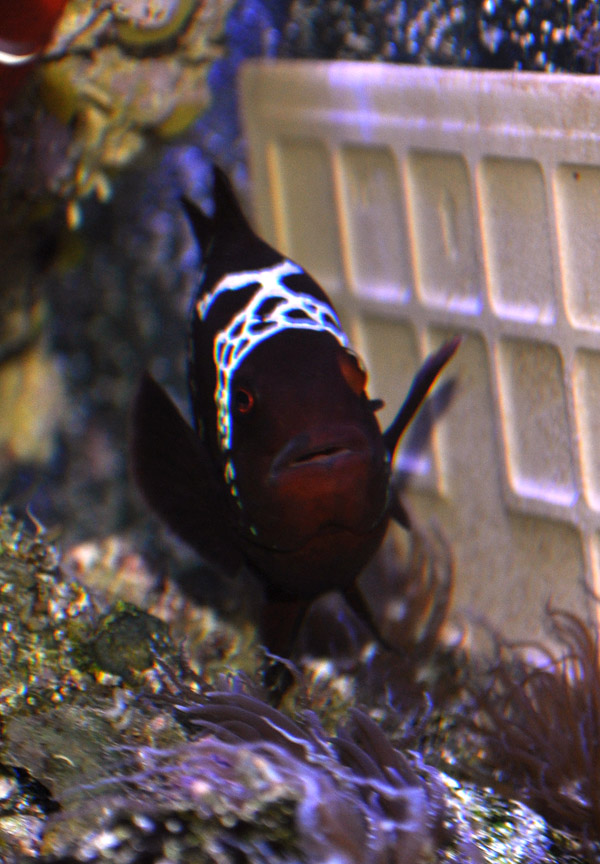
You can see the difference in the right upper maxilary…certainly scarred at this point, but not the raging infection. And the appetite returned. Plus, on Friday, the Lightning Maroon saw fit to go on a rampage of the sandbed, moving Goniopora and other corals around that had been left alone for months.
- About The Lightning Project
- Inventory of F1 PNG Lightning and White Stripe Maroon Clownfish
- F1 PNG Lightning Maroon Clownfish, BZLM1
- F1 PNG Lightning Maroon Clownfish, BZLM2
- F1 PNG Lightning Maroon Clownfish, FW1
- F1 PNG Lightning Maroon Clownfish, LM10
- F1 PNG Lightning Maroon Clownfish, LM11
- F1 PNG Lightning Maroon Clownfish, LM12
- F1 PNG Lightning Maroon Clownfish, LM13
- F1 PNG Lightning Maroon Clownfish, LM14
- F1 PNG Lightning Maroon Clownfish, LM15
- F1 PNG Lightning Maroon Clownfish, LM16
- F1 PNG Lightning Maroon Clownfish, LM17
- F1 PNG Lightning Maroon Clownfish, LM18
- F1 PNG Lightning Maroon Clownfish, LM19
- F1 PNG Lightning Maroon Clownfish, LM20
- F1 PNG Lightning Maroon Clownfish, LM3
- F1 PNG Lightning Maroon Clownfish, LM4
- F1 PNG Lightning Maroon Clownfish, LM5
- F1 PNG Lightning Maroon Clownfish, LM6
- F1 PNG Lightning Maroon Clownfish, LM7
- F1 PNG Lightning Maroon Clownfish, LM8
- F1 PNG Lightning Maroon Clownfish, LM9
- F1 PNG Lightning Maroon Clownfish, MD1
- F1 PNG Lightning Maroon Clownfish, MWP3
- F1 PNG Lightning Maroon Clownfish, WS17
- F1 PNG Lightning Maroon, EC1
- F1 PNG Lightning Maroon, GL1
- F1 PNG White Stripe Maroon Clownfish, BZWS1
- F1 PNG White Stripe Maroon Clownfish, BZWS2
- F1 PNG White Stripe Maroon Clownfish, BZWS3
- F1 PNG White Stripe Maroon Clownfish, WS10
- F1 PNG White Stripe Maroon Clownfish, WS11
- F1 PNG White Stripe Maroon Clownfish, WS12
- F1 PNG White Stripe Maroon Clownfish, WS13
- F1 PNG White Stripe Maroon Clownfish, WS14
- F1 PNG White Stripe Maroon Clownfish, WS15
- F1 PNG White Stripe Maroon Clownfish, WS16
- F1 PNG White Stripe Maroon Clownfish, WS4
- F1 PNG White Stripe Maroon Clownfish, WS5
- F1 PNG White Stripe Maroon Clownfish, WS6
- F1 PNG White Stripe Maroon Clownfish, WS7
- F1 PNG White Stripe Maroon Clownfish, WS8
- F1 PNG White Stripe Maroon Clownfish, WS9
- F1 PNG White Stripe Maroon, EC2
- F1 PNG White Stripe Maroon, FW2
- F1 PNG White Stripe Maroon, GL2
- F1 PNG White Stripe Maroon, MD2
- Lightning Breeding Directive
- Lightning Maroon Clownfish Links
- Home
- About The Lightning Project
- Inventory of F1 PNG Lightning and White Stripe Maroon Clownfish
- F1 PNG Lightning Maroon Clownfish, BZLM1
- F1 PNG Lightning Maroon Clownfish, BZLM2
- F1 PNG Lightning Maroon Clownfish, FW1
- F1 PNG Lightning Maroon Clownfish, LM10
- F1 PNG Lightning Maroon Clownfish, LM11
- F1 PNG Lightning Maroon Clownfish, LM12
- F1 PNG Lightning Maroon Clownfish, LM13
- F1 PNG Lightning Maroon Clownfish, LM14
- F1 PNG Lightning Maroon Clownfish, LM15
- F1 PNG Lightning Maroon Clownfish, LM16
- F1 PNG Lightning Maroon Clownfish, LM17
- F1 PNG Lightning Maroon Clownfish, LM18
- F1 PNG Lightning Maroon Clownfish, LM19
- F1 PNG Lightning Maroon Clownfish, LM20
- F1 PNG Lightning Maroon Clownfish, LM3
- F1 PNG Lightning Maroon Clownfish, LM4
- F1 PNG Lightning Maroon Clownfish, LM5
- F1 PNG Lightning Maroon Clownfish, LM6
- F1 PNG Lightning Maroon Clownfish, LM7
- F1 PNG Lightning Maroon Clownfish, LM8
- F1 PNG Lightning Maroon Clownfish, LM9
- F1 PNG Lightning Maroon Clownfish, MD1
- F1 PNG Lightning Maroon Clownfish, MWP3
- F1 PNG Lightning Maroon Clownfish, WS17
- F1 PNG Lightning Maroon, EC1
- F1 PNG Lightning Maroon, GL1
- F1 PNG White Stripe Maroon Clownfish, BZWS1
- F1 PNG White Stripe Maroon Clownfish, BZWS2
- F1 PNG White Stripe Maroon Clownfish, BZWS3
- F1 PNG White Stripe Maroon Clownfish, WS10
- F1 PNG White Stripe Maroon Clownfish, WS11
- F1 PNG White Stripe Maroon Clownfish, WS12
- F1 PNG White Stripe Maroon Clownfish, WS13
- F1 PNG White Stripe Maroon Clownfish, WS14
- F1 PNG White Stripe Maroon Clownfish, WS15
- F1 PNG White Stripe Maroon Clownfish, WS16
- F1 PNG White Stripe Maroon Clownfish, WS4
- F1 PNG White Stripe Maroon Clownfish, WS5
- F1 PNG White Stripe Maroon Clownfish, WS6
- F1 PNG White Stripe Maroon Clownfish, WS7
- F1 PNG White Stripe Maroon Clownfish, WS8
- F1 PNG White Stripe Maroon Clownfish, WS9
- F1 PNG White Stripe Maroon, EC2
- F1 PNG White Stripe Maroon, FW2
- F1 PNG White Stripe Maroon, GL2
- F1 PNG White Stripe Maroon, MD2
- Lightning Breeding Directive
- Lightning Maroon Clownfish Links
Browsing Posts published by TheLightningProject
It’s 3:15 AM, Thursday, May 3rd, I really should be in bed, but I know folks are wanting updates 😉
Monday, April 30th, 2012
By Monday, it seemed that nothing was progressing, and towards the evening, the slightly more “bold” Lightning Maroon personality had returned. I did a 5 gallon water change and once again dosed the tank with both Maracyn and Maracyn II, both the marine / saltwater formulations.
It is interesting to note that I had a loss by this point – an Acropora frag that had been browned out for months, and had a little bit of cyanobacteria growing on it, well, that coral kicked the bucket during this treatment. IRONICALLY, it almost appears as if the Pink Birdsnest and Sour Apple Birdsnest are showing more intense coloration than ever…could be the water changes, could be something in the medication…hard to say at the moment. But I really want to hit home the efficacy of these two anti-bacterial products and their very apparent relative safety in reef tanks. Hobbyists are always scrambling for reef-safe medications, and in this case, I think you have very safe anti-bacterial agents to treat suspected bacterial infections in a reef tank. IF you must.
Tuesday, May 1st, 2012
Officially a crazy day in the Pederson household. By this point I was probably telling those who inquired privately that I was slowly gaining optimism that my course of treatment had been effective. Overall, I barely looked at the tank though other than to treat it.
Wednesday, May 2nd, 2012.
Another day of simply being very busy and stretched thin…our first summer-like day in Duluth had me spending most of my freetime in the afternoon trying to do some much needed outdoor work in the wind of opportunity that presented itself. Plus I’ve been busy with my work on the Banggai Rescue project. I did take a quick peak at the Lightning Maroon and dare I say it, it does appear that the infected areas of the maxillary are possibly even healing? It could quite well turn out that the fish may not lose the maxillary as I had feared, and quite possibly, it may not even be scarred when it’s all said and done?
Before I knew it, 2:00 AM had already arrived and I had neglected to treat the Lightning Maroon. So I did a 5 gallon water change, and treated the tank. According to the manufacturer’s recommended treatment regimes, I’ve gone one extra day with the Maracyn and have completed the Maracyn II treatment course as well, albeit slightly late there at the by about 12 hours!
So what’s next?
The biggest question at the moment is whether I continue to treat with the antibiotics. Instructions on the packaging say to treat for 5 days even if symptoms disappear. But what if maybe they haven’t? Do I keep going? I may make some calls, ask around, or just by myself personal comfort time by going yet one more day. Afterall, there are diseases in humans that we have to treat with 30-day long antibiotic courses – I absolutely do not want to stop prematurely.
I obviously owe you all pictures. That will be on my to-do list for tomorrow when I wake up.
The long-term question is how do I prevent this from recurring. The concern is that while I perhaps got lucky and made the right decisions this first time around, if it comes back, it may be harder to treat (due to built up resistance). Obviously these fish already receive the most attention in the house most days, and are always the first to receive care and maintenance. And yet I still had a problem with a bacterial infection.
Most of the time, we think of bacterial infections as being caused by poor water quality. But the reality there is that I maintain close to sps-level water parameters, have a good skimmer, etc. So what could be going on here?
One of the things that had occurred to me is my use of very low-level vodka dosing. We know that carbon-dosing elevates bacterial populations and in doing so, helps “bind up” our nitrates in the actual bacterial mass. But could the carbon-dosing also cause elevated levels of pathogenic bacteria, and have indirectly caused this to happen? Obviously I’ve stopped vodka dosing during the entire treatment because I don’t have any effective skimmer at the moment (treatment with these antibiotics causes the skimmer to go truly haywire..I’m just letting it all spill back into the tank). My vodka dosing was at extremly low levels (1 drop per day) but still, maybe that was too much.
Of course, the above is entirely conjecture, just a hypothesis at best. The other possible things to look at IS the introduction of the tile. I have legitimate concerns that the Lightning Maroon perhaps damaged its mouth when trying to evict the tile from its territory. If in fact the tile was indirectly related, I am hoping that its ongoing presence has simply become accepted, and thus, will no longer cause violent objections to its presence in their territory.
And then there’s another thing we must consider. As with all wild caught fish, we have no clue how old they are. In the case of a Clownfish, I recall reading scientific documentation of a wild-caught Percula being 32 years of age. Most probably live far less, but still, if you live your life as a male, and your female lives a long time too, well, you stay small and live a long time. It is quite possible that our Lighting Maroon could be 5, 10, 20 years old already. There is, quite sadly, the possibility that the Lighting Maroon *could* already be old, and thus, could be slowly starting to slide downhill. Let’s hope it never comes to that, yet it is inevitable that sooner or later, the Lightning Maroon IS going to die. Realistically, odds are more likely that the Lightning Maroon was perhaps on the younger side of things, but then again, you don’t really know. When she does finally pass on, I’ve already committed to contributing her to scientific research.
So that’s where things stand. Please keep sending the well-wishes, as I am not going to make George W. Bush’s mistake and declare “mission accomplished” just yet.
Friday, April 27, 2012.
I’ll keep this short and bittersweet. In the last 24 hours the Lightning Maroon has developed a pretty rapid spreading case of what appears to be mouth rot. You may recall a similar situation occurring with the Morse-Code Maroon, and that did not end well.
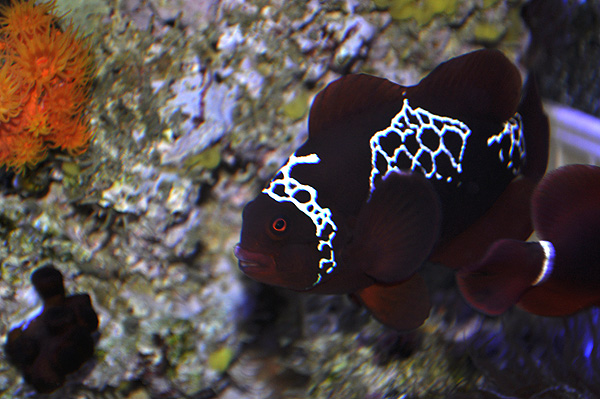
The biggest question is WTF – or more appropriately, WHY?! Did I introduce a pathogen from the Onyx Percula tank? It’s possible, but that group of fish has been disease free for who knows how long, and would qualify to be every bit as QT’d as the Lightning Maroon. PLUS, the Four Eye Butterflyfish that they reside with was taken from the Onyx Perc’s tank originally. So odds are that there was nothing new introduced.

Does it have something to do with the eggs? Could be. Could be that eating fungused eggs exposed the fish to elevated bacterial / fungal levels which in turn has led to infection. Or it could be the tile surface is somehow abrading the lips as they clean, and again opening a pathway to infection.
Or could it be something more sinister? If I’m blunt, perhaps the pop-eye I saw earlier on was not in fact a “bruise”, cauesed by mechanical damage, but was in fact an early warning sign for infection. If I really read some of the symptoms listed out, it actually sounds like a disease called Ichthyophonus hoferi, which is an internal fungal infection, with the exception being that the Lightning Maroon is not exhibiting any of the erratic behavioral symptoms.
However, this disease does most closely match the symptoms of classic mouth-rot, which is treatable with Erythromycin (one of the rarer ones). In fact, you can pick up a package of Maracyn SW and pretty much it deals with all of these symptoms. I keep it on hand, and I’ve found it to be very reef-safe, so without hesitation, I removed the carbon and dosed the tank today with the first dose of Maracyn SW. As of this evening, I have seen no improvement, and in fact, it does appear that the Lightning Maroon lost it’s appetite tonight. This is NOT GOOD.

I am toying with the notion of removing the egg tile. I’m looking at the Aiptasia in their vicinity and wondering if I need to eradicate those as well (haven’t caused any problems before, so why would they now…but maybe I still should). I am thinking of hitting both the Gram Positive AND Gram Negatives by including Maracyn II SW (Maracyn hits Gram Positive infections). I’m thinking about moving the fish into a well established QT tank. The options are endless, but it’s a situation like this where I hate being the fish vet, because the long-standing hobbyist in me has not seen a tremendous success rate in treating these types of infections. Of course, in the last 7 years, there has been only one other fish to have this issue…and that was another PNG Maroon. What are the odds?
All fish will die, that’s a given fact. But damnit, I will be really bummed if this is how the story of the Lightning Maroon comes to pass. And yeah, I’m really going WTF…this is the type of disease that really just should never happen in a clean, well maintained system. WTF?!
Saturday, April 28th
I half expected to wake up to a dead Lightning Maroon, but it wasn’t. It’s appetite was “not great”. So one of the big questions here is how to turn this around. I started medicating with Maracyn SW yesterday, but that only treats gram-positive bacterial infections. While the symptoms match up well with the symptoms of diseases Maracyn is supposed to treat, would it actually work?

And so, I embarked on a search for the companion product, Maracyn II SW. The active ingredient is Monocycline. I was 30 minutes into a 6 hour round trip to the only store in the Twin Cities that had the medication on hand (Ocean Devotion), when I got a call back from local reefer Frank Wotruba saying he had it on-hand. Shortly therafter, Jay Hansen also called saying he had it on hand. This is a great example of the benefits of being am actively participating member of a marine aquarium club.
I picked up a package of Maracyn II SW from Frank, and headed home. I had put in a call to Sentry AQ, the current manufacturers of Mardel aquarium medications, as I wanted to confirm that I could use Maracyn SW in conjunction with Maracyn II SW. The woman who I spoke with was kind, if not helpful, as the fish guy was out to lunch. I never did get a call back despite leaving my information, but later I found an acceptable answer on the website:
“Yes, Mardel Maracyn can be used in conjunction with almost all Mardel fish medications. The only exception would be Maracyn Plus. (We do not recommend using another antibiotic with Maracyn Plus.)”
This means that the two can be conjoined, and so, without delay, I added in the first dosage of Maracyn II for marine fish to the Lightning Maroon’s tank. I think we’re looking at a pretty strong case to be made that both these anti-biotics are completely reef safe…although your water will glow yellow with the blue lighting.

Sunday, April 29th, 2012
Once again I woke up expecting to find a dead Lightning Maroon. The spread of the mouth rot seems to have stopped, but there is definitely necrotic tissue breakdown happening. It is possible that even if I save the fish, it will loose at minimum the upper right maxillary. Thankfully that’s not a problem for a fish; they actually use maxillary clips in young salmonids to help with strain and year class identification in hatchery fish. Still, outwardly, things do not look any BETTER. Yes, I have contemplated surgery.
Knowing that Maracyn II SW treats gram negative bacteria, and knowing that will more likely impact biological filtration, I did a 10 gallon water change around noon. The Onyx Perc eggs hatched overnight, and the fish overall are ignoring the tile. I did use some Tropic Marin ElimAptasia to knock back the larger anemones…while the fish might be protected, I wonder if the infected area is getting stung by the Aiptasia and screwing up the healing process. After this work, I dosed with both Maracyn SW and Maracyn II SW. So this is day 3 for Erythromycin, and day 2 for Monocycline. And yes, looking back at the Morse Code Maroon now, I know I switched to this combination of medications after Kanamycin failed to give me any results. If I am dealing with an internal fungal infection, particular the type that can be introduced through the feeding of raw fish (I have no clue what foods, if any that I have, contain raw fish), there is little I can do as far as my reading suggests. Still, I may have to switch here and go to a hospital tank if what I’m doing at this point fails to work. Yes, I am thinking of plan B now.
I truly have no clue how this will all turn out, and I am beyond frustrated. That said, I’m also completely confident that I’m doing the best I can with the materials I have, so there’s no burden of guilt here. Solely the stress of fighting off what could be the end of a 2 year effort to breed this magnificent fish.
This has been an interesting weekend for the Lightning Maroon. It started Friday AM, when I woke up to find the Lightning Maroon with a cloudy and swollen right eye. That alone ruined my day, although I didn’t freak out because I realized that this was likely a bruise / mechanical damage. Still, in the name of precaution, I fed the tank Dr. G’s Anti-Bacterial frozen food, and am following the regime for that just to be sure and hopefully safe. It is now Sunday night, and the eye has all but returned to normal.
Meanwhile, later on Friday, I noticed that my female Onyx Percula was looking extremely distended and swollen…definitely a spawn coming. They’ve moved nest locations over the years and have slowly worked their way from the upper back, to the lower back panel of their aquarium. So I placed a tile over their last nest in the hopes that they’d spawn on it. VERY late that night, I found them doing this:


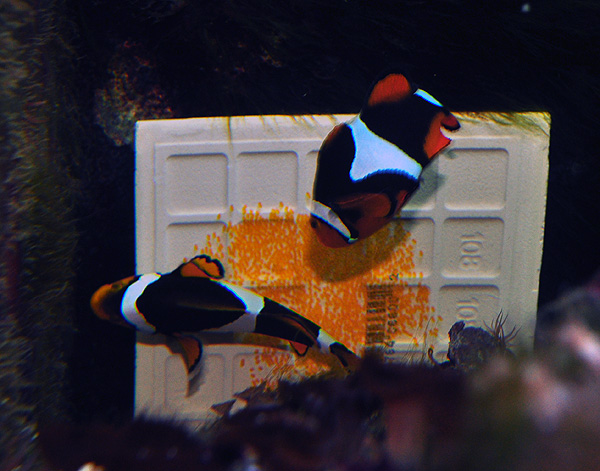
Now, this is probably something like their 200th spawn (I stopped counting years ago). Up here, we don’t have a huge market for Onyx Perculas (or any clownfish) so at best, I might raise a batch every year now. This time, I had been waiting to do something in the “bag of tricks”, something clownfish breeder Mitch May (a.k.a. Booyah) likes to do, called a “Double Down”. I *think* I’ve mentioned it here before, but if not, well, here’s a synopsis.
The jist of the “Double Down” is to take the nest from an actively spawning pair of clownfish and give it to surrogate or foster parents, in this case a pair of clownfish that has yet to spawn. As Mitch tells it, they’re generally going to do one of two things. Tend the next, or eat it. If they eat it, no harm, no foul, the eggs are stellar nutrition for the non-spawning pair. If they tend the nest, Mitch relayed that he’s found that it helps a reluctant pair to “get the idea”..that is to say, it often kicks them into spawning mode in short order.
So tonight, about 48 hours after the next was laid, I pulled it from the Perculas and gave it to the Lightning Maroon Pair. The Onyx Percs are my longest living pair to date…they were the first pair of clowns we got when my wife gently nudged me into setting up a saltwater tank for her way back in the day. They come from a tank that hasn’t seen a new fish in 9 months (and that “new” fish was removed about a month ago). So it’s a solidly reliably, trustworthy tank.
Now remember, the PNG Maroon that was paired with the Lightning Maroon is in fact a fully functional male Maroon that was successfully spawning while paired with a large Gold Stripe Maroon (this temporary pairing was set up to prevent the PNG maroons I received from turning male). I had very little doubt as to the male’s ability and instincts. The nest went in with the Maroons, and initially, the Lightning tried to push the tile out of her territory.

I put it back, only to hear it whack against the glass. Did it again, and this time took video.
So I really wedged it into the gravel, with a large rock pinning it up flat against the back of the tank, in the general area that they normally clean. It’s probably been an hour now, and I haven’t heard the tile get thrown against the tank glass again, so hopefully it will stay in place. Hopefully. At any rate, once the tile was in place, it seemed pretty clear that the Lightning Maroon was having mixed feelings…given that she is tending the nest occasionally with the male. Let me once again be undeniably, crystal clear.
THESE ARE NOT LIGHTNING MAROON CLOWNFISH EGGS, they are PERCULA eggs being FOSTERED by the LIGHTNING MAROON PAIR.
Still, some IDIOT will NOT READ THIS and say “OMG the LIGHTNING CLOWN SPAWNED!”. Sorry, NO. They are FOSTERING Percula eggs 😉
I admit, it’s pretty cool to see even if it isn’t their own eggs…yet.
I don’t test my water all that often these days – I’ve long since learned that you can assertain a lot of what is going on through observation, and the basics of pH and Temp are constantly monitored. Still, I do check things once in a while to make sure we’re not too far off track. Seeing a slight decrease in SPS coloration in the Lighting Maroon’s tank, it made me wonder where the Nitrates and Phosphates were sitting. With Sanjay Joshi and Tal Sweet due to bet here next weekend, I’d like this tank looking its best. So might as well use our low-key morning at home (our son has been sick with a 102-103F fever for 4 days now) to do an Easter-morning water test:
pH (Apex) – 8.15
pH (Seachem) – 8.0
Alkalinity (Seachem) – 2.0 meq/L
Looks like my pH probe is starting to drift again and in need of calibration (it could be old enough now that it technically should be replace). After these tests, I dosed with C-Balance 2 part, and then later, continued with water tests.
Nitrate (Instant Ocean) – < 10 ppm
Nitrate (Salifert) – 5 ppm
Phosphate (Instant Ocean) 0.4 ppm
Magnesium (Salifert) – 1275 ppm
Calcium (Salifert) – 400 ppm
Meanwhile, I did test the “restarted” display system. This system to be exact:
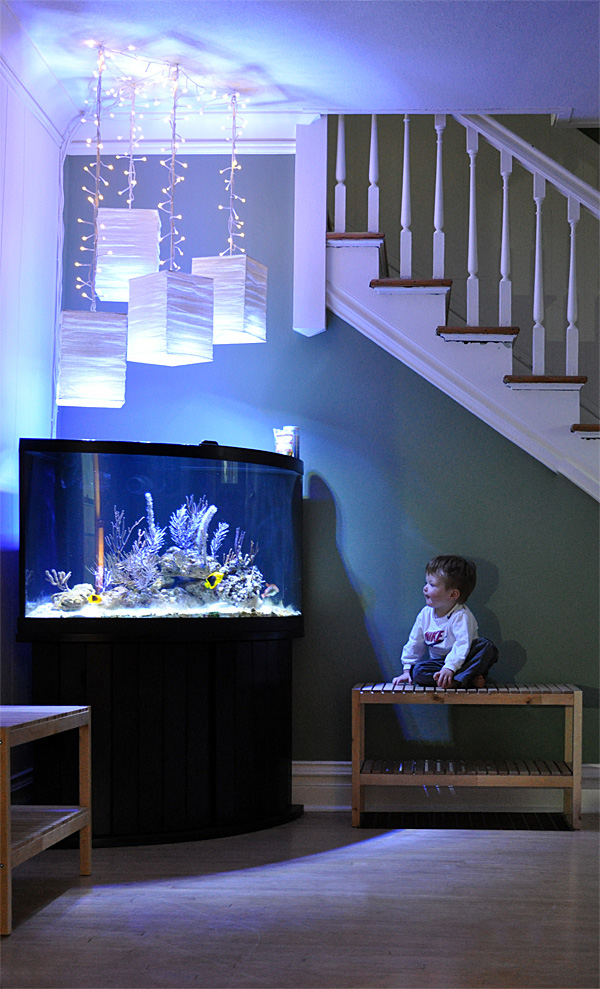
I was surprised to see Nitrates of possibly 25-40 PPM, and Phosphates greater than 1.0. Glad I recently started running GFO (Granular Ferric Oxide) in both these systems. I had cut back on the Vodka dosing to the Lightning Maroon’s system, down to 1 drop per day, but maybe 2 drops is my magic number. Meanwhile, the 450 gallon display system has been getting roughly 10 drops per day of Vodka, and I’ve been waiting for a Two Little Fishies Bio Pellet reactor. Now seems like the opportune time to add it on. I may also do some Kalkwasser dosing on the big system. It will be interesting to see how the different ongoing nutrient management protocols I’ve been employing (in addition to water changes) will play out in the months ahead.
I hope you all had a wonderful holiday weekend and share the optimism that comes with this time of year.
Yes, there is one sure fire way to get an update – heckle me into it via the comment system here at www.Lightning-Maroon-Clownfish.com
So for starters, let’s talk NPS (Non PhotoSynthetic corals). Yes, I’ve had some Balanophyllia for a while now, as a somewhat local reefer grows them like crazy and they always end up donated to our club for fundraising…but no one out there actually pays what they’re worth, so I always do. Well, they’ve been doing great despite outright neglect. With a mandate to get some Tubastrea for our club’s fragging demo too, it seems I’ve become a NPS guy…at least a little bit. We received an Aussie Black Tubastrea, and I wound up buying all the frags we made of that. And I even went and found some orange Tubastrea recently to help round out the NSP nook in the Lightning’s tank. Afterall, the hardscape we constructed did leave a large portion of the tank and rockwork shaded, so NPS is a logical addition there. And what I’m learning is that the fish benefit from the feeding too (since I make sure to include things like brine shrimp and fish eggs). So it’s really no harm to feed the NPS since I have to feed the fish heavily anyways. So without delay, here’s the NSP nook.



Now I know you want an update on the Lightning Maroon, Ted, but I’m not ready yet. Afterall, one of the reasons I shot photos today (since I shot these before you gave me that nudge) was to document the ORA Red Goniopora I’ve been keeping. For a long time I’ve been watching it and thinking the polyps were not extending as far as they used to, but it turns out that’s not the case. The coral is in fact getting LARGER (so the polyps are the same length as always, just proportionately smaller). How do I know this? Well, I looked back to the photos I took for CORAL magazine last year and that was a dead giveaway. But then again, so was this:

Um, yeah, I didn’t put it that close to the glass last year. Someone has been doing some growing.
So about those pesky PNG Maroon Clowns? Yeah, they have been going through the motions of nest cleaning since MACNA 2011…aka September of last year. STILL no spawns that I am aware of. We’ve lengthened the light time period, the tank has gotten warmer with the onset of spring, and still nothing. I know it will happen, and after being reminded by commercial breeders who’ve sat on clownfish for 5+ years before getting spawns, I know this can simply take a while. So I’ll leave you with a full tank shot for now, which if nothing else is proof of how well the Ecoxotic Panoramas are growing the SPS corals these days!

Yes, made it a point today to check how things are going in my own “super [fish] bowl”…that is the Ecoxotic cube tank that holds the Lightning Maroon. I’ve been Vodka dosing lately and it certainly seems to be helping the corals show their ideal colors, although the Green and Purple maricultured ORA Gonioporas really have not been doing well (meanwhile the ORA Red is growing like crazy, and my Aussie Pinks are putting on growth too…the Aussie Greens, I’m not sure).
At any rate, when I check water last week my nitrates were down to 5 PPM. Lately I’ve switched my in-house salt use; since most of my tanks are not reef tanks, it made no sense to be putting in extra cash on reef-grade salt. So, I’ve been mixing 50% Reef Crystals with 50% Instant Ocean. I’m continuing with regular partial water changes as well as the vodka, iron, iodide, and Reef Plus. The biggest thing I’m noticing is that I’m once again having pH swings that trend low – a quick pH test confirmed my probe is not out of adjustment. This is all happening with daily doses of C-Balance 2 part (6 ML each). So, where are things sitting today, on Super Bowl Sunday?
pH (Apex) – 8.06
pH (Seachem) – 8.0
Alkalinity (Seachem) – 2 meq/L
Nitrate (Salifert) – < 5 ppm
Calcium (Salifert) – 420 ppm
Magnesium (Salifert) – 1305 ppm
Phosphate – was going to test it as I’ve never bothered…test kit defunct.
Calicium and Magnesium look fine, so I’m thinking I just need to tweak the Alkalinity a little bit…so maybe a dose or two of either Seachem’s Reef Builder or Reef Buffer ought to do the trick and knock off the low end pH overnight. Overall, I’m pleased with the results of my low-level routine Vodka dosing – colors on the Seriatopora have dramatically improved.
Nothing special to report on the Clowns…they just keep acting like a pair but no eager reproductive activity.
UPDATE
I did some digging and found that I DID have an Aquarium Systems Phosphate and Nitrate Test Kit sitting around – I bought this back when I lived in Chicago, so I know it’s old. But there’s no expiration date on the kits, and as far as I can tell, they *seem* to work. The results?
Phosphate (Aquarium Systems) – 0.4 ppm
Nitrate (Aquarium Systems) – < 10 ppm (gradations on this test are 10, 20, 30, 40, 50 – the resolution is pretty coarse)
Turnabout is fair play – come here to shoot the Lightning Maroon Clownfish and expected to get shot yourself (granted, I asked for permission to both shoot and post 😉 )
I have to say, Gary was a trooper – our club brought him to Duluth, MN, only to drive him 3 hours west to Bemidji, MN, and then back again. Throw in delayed flights both ways (Chicago’s fault!). Still, I have to say, it’s rare that an aquarium speaker gives such a universally accessible presentation – not a single person in that room left without learning something about photography. I think it’s fair to say that many people were inspired.
If you want an update on the Lightning Maroon Clownfish, this time around I’ll point you to Gary’s post for his thoughts (and some more great Lightning Maroon photography) at Reefs.com – http://www.reefs.com/blog/2012/01/28/looking-at-lightning/ . If you didn’t already know, Gary is one of the two voices you’ll hear most weeks doing the Reef Threads podcast too. I haven’t listened to it yet, but I’ve already noted that The Lightning Project is a topic of conversation this week – http://www.reefthreads.com/?p=1351
For now, I’ll leave you with some rare glimpses of the master at work. Gary spent most of the morning shooting as Little Miss Lightning wasn’t being very cooperative! Gives you another look at the Ecoxotic tank too – the Rod’s Food shirt draped over it was to cut down on light spillage. Enjoy!

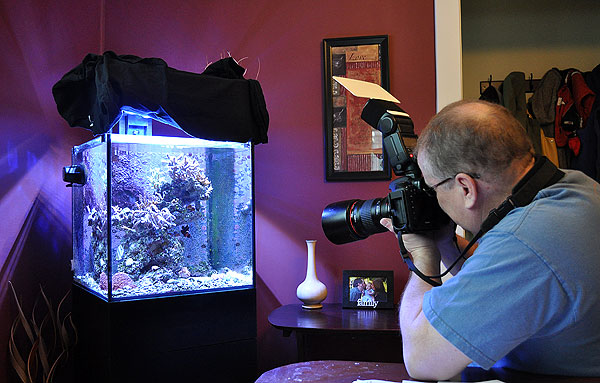

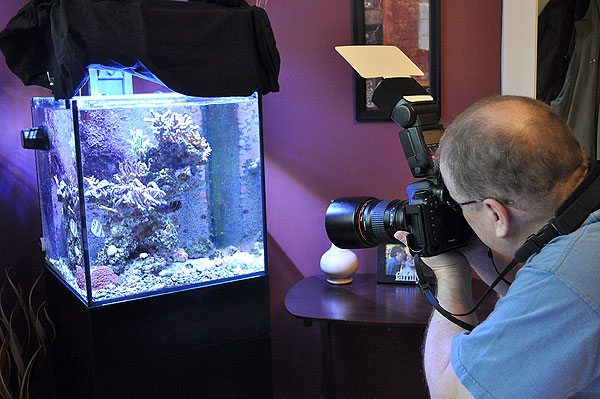

Patience…it’s a virtue.
With SOPA and PIPA making news this week, it’s all too timely to bring up a brief discussion about copyright. I was 100% against these measures because they lacked the necessary protections of due-process…all it takes is an accusation to bring down an entire server, a server which could house dozens or hundreds of unrelated websites. Never-mind whether the accusations are even true.
That said, copyright is some pretty serious business. What people don’t realize is that some of the aquarium industries most valuable photographers are actually reducing what they publish because rip-offs are simply too prevalent. To date, there have been only three people here in my home shooting high-quality photography of the Lightning Maroon Clownfish.
First is Tony Vargas. He shot for over an hour, to the point of almost ignoring the other 16 tanks in my house! Tony takes copyright so seriously that he releases few if any images from his work, and when he does, he’s forced to watermark right over the subject, like this:
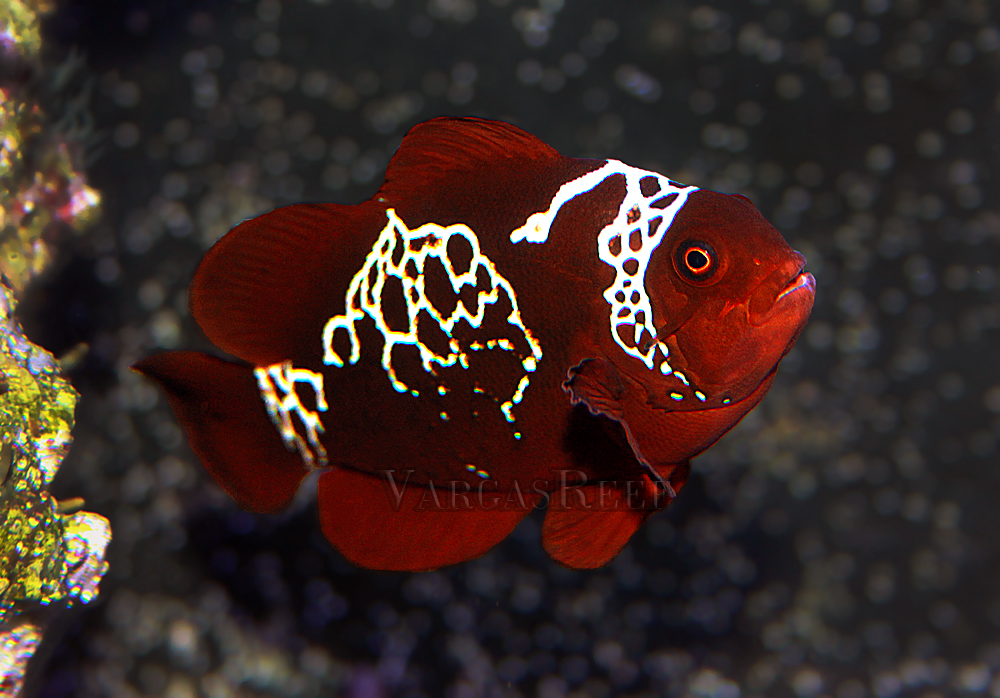
It’s a shame that Tony must do this, as a watermark is, in my opinion, very obtrusive. However, Tony has been driven to this as a stern measure to help enforce the copyright over his work. You (the vague, amorphous, internet community at large) are to blame.
Marc Levenson has been here too and photographed the Lightning Maroon. It’s fair to say that Marc shares my dislike of watermarking over a photographs subject. So instead, he places a photo credit within the picture, but off to the side or bottom so it doesn’t interfere. For example, this:

Better yes, but certainly such a mark is easily cropped off this image. I implemented such an image strategy in an earlier business, and routinely found my images being used by my competitors to sell competing products….they’d just cut off the watermark and use the image as if it was their own. Policing this was a nightmare. I invested thousands of dollars to create this photography to sell my products and they’re stealing it and underselling me. You bet it drove me insane. It was HIGHLY wrong and quite illegal to do what they were doing.
But in the end, I still did not choose to watermark my images as Tony had done. So really, if I’m not going to watermark every image I put up here because I want this audience to enjoy unfettered images, what am I asking of you, the reader?
Well for starters, I’m asking you to not steal my images. We’re not even through the first month of 2012, and I’ve already been notified of 2 unauthorized uses of my Lightning Maroon photography. Certainly some of you may ask “what’s the big deal”?
First off, it’s because they didn’t ask. Yes, often times all it takes is to say what image you want to use, why you want to use it, and often you’ll get positive response from the average photographer who isn’t doing it for a living. Yes, Tony and Marc both gave their blessings for me to share their photography here on the website.
Of course, Marc and Tony were invited to my house. They shoot photos of my property, without offering any compensation to do so, so there’s an understanding and respect there from the get go…i.e. I’d hope that these friends of mine would contact me and suggest me first if anyone came to them looking to license Lightning Maroon photography. By the same token, Tony has one image that I’ve said “that’s the cover of my BOOK Tony, that’s awesome, and I’d hope he’d be kind enough to simply let me use the image gratis (since it is my fish in my tank afterall, shot with my permission)..but I’d still make sure he’s compensated in some way because man, a book cover of that caliber…he deserves it.
So yes, even with ALL of this “unspoken understanding”, I still showed my friends the courtesy of ASKING before using their images here on TLP. And still, it’s important to note that technically, if Marc or Tony wanted to commercially use their photography of the Lightning Maroon in my home, they’d have to obtain a property release form from me in order to do so (and if I wanted to be a jerk, I could make them pay me for that release)- it’s that much more important because the Lightning Maroon is a one-of-a-kind, instantly recognizable fish that over time has also become synonymous with me. Still, so much of this in the aquarium world functions on mutual respect and the understanding. And despite that, every image I use in a story on Reef Builders is either creative commons, my own, or one that I’ve ASKED to use first.
But the fact that this month’s infringers didn’t ask to use my photography is almost trivial…in both cases this year if infringers had asked for permission, I would’ve said “no”, you can’t use this image in this manner. But still, understand that I might say “yes” just as easily to some future inquiry, or I might say “for that use, I’d be willing to license the image”.
In the two cases this year, I didn’t get paid either way. That’s theft. Granted, I wouldn’t have offered to license these images either. Doesn’t make it OK to steal them then. If you can’t afford it, or it’s not available for purchase, theft is not the solution. You’re not starving and my images are not a loaf of bread.
But the real conundrum here is that along the way, this iconic fish has become synonymous with my personal name. So when someone uses my photography of a one of a kind fish that I own, people recognize it. Instantly. And I’ve found it directly associates back to me.
The use of my Lightning Maroon photography in commercial settings creates a connection between myself and the activities of the person who isn’t authorized to use the imagery in the first place. It’s interesting because in both cases of infringement this month, I found out not by my own hand (it never happens that way) but because people contacted me to say “Hey, do you know this person that’s using the Lightning Clownfish in this way here on the internet? What can you tell me about their product/service/business?”
Well guess what kind of response your business / project / service gets when I find out you’re stealing my photography and along the way, creating the illusion of an unspoken, unofficial endorsement by me? Do you think I have glowingly wonderful things to say about you and your business?
I’m not going to go into the realities of copyright law here. Yes, I’m trained in it; understanding copyright was crucial in my professional line of work. Here’s the important pieces of advice, both for me, and in general:
- If you’re re-posting a Lightning Maroon Clownfish image of mine on a forum or something to say “Hey, check out this new shot” and you attribute it to me and link to the blog, I’m not going to have a problem with that, I get that, and you’re not causing me any harm by doing that. However…
- If you find an image of the Lightning Maroon out there in any other capacity, that wasn’t published by me, a vendor who handled the fish (Pacific Aqua Farms, Blue Zoo Aquatics), or someone who’s known to have photographed the fish (Ret Talbot, myself, Marc Levenson, Tony Vargas, and soon to be Gary L. Parr), please let me know immediately as it is probably an unauthorized use.
- The Lightning Maroon’s likeness will never be licensed out for use as part of any brand identity..i.e. you’ll never see a logo with the Lightning Maroon in it unless it’s something I’ve done, for me (i.e. if I have babies to sell someday). Anything even remotely commercial at this point, chances are it’s unauthorized and I want to know about it.
- If you want to use any images of the Lightning Maroon, in a commercial or journalistic setting, please ask first so we can discuss whether I’m comfortable with the use, and any potential licensing arrangement.
- Any image, text, etc, is covered by copyright the second it is created. It does not require a copyright symbol, sign, watermark or any other notation to be copyright protected. Just because it doesn’t say “Copyright Matt Pedersen 2012” on the image, doesn’t mean it’s not my image.
- All you really need to know is a very simple test – if you didn’t create it yourself, and you didn’t license it from someone else who did, then you don’t have any claim of copyright on that work. Using it in just about any setting could have you violating copyright. Again, not going to get into “fair use” cases because frankly, in the aquarium hobby world and industry there aren’t many likely scenarios for a fair use claim to arise.
- In general, if you’re just rumbling around the internet and find a picture you want to use for something, ask first.
- If you don’t know who’s image it is, find out.
- If you can’t find out, move on and find another image.
- Or go find an image on Flickr that’s available for attribution only license via Creative Commons
- Bottom line, real simple, if you want to stay above board, avoid public embarrasment, avoid nasty emails, and avoid a bad reputation, make it yourself.
It’s really simple folks. Life is better for everyone if we respect the creative works of other people. It costs real money and time to create and publish these works for you to enjoy. It is one thing to share and attribute those works to promote them (although you’re probably still violating copyright law), but it is an entirely different story to use images in a commercial manner of any kind, let alone in a manner that appears to create an endorsement or partnership where none exists.
As usual, there’s really nothing NEW to report. The blog’s admin area was offline for a while – the result of a failed automatic WordPress update. I finally got around to fixing it!
Since there’s nothing new to report (other than the pair of Maroons being a pair of Maroons) I thought I’d first update you all with a link to Marc Levenson’s story about visiting the Lightning Maroon (and TONS of new pictures that Marc shot – I stole the one above from his post). You’ll find it here on Reef Addicts.
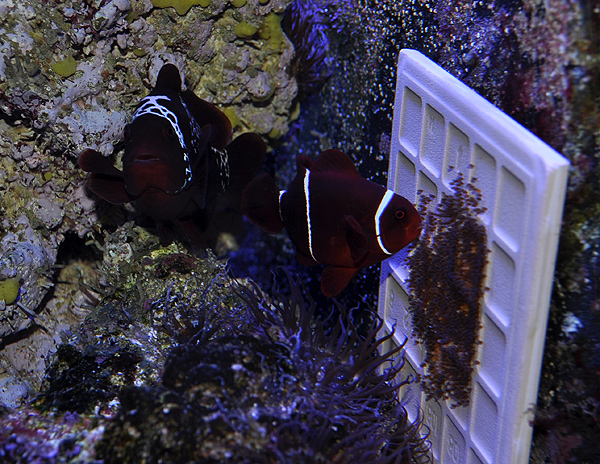
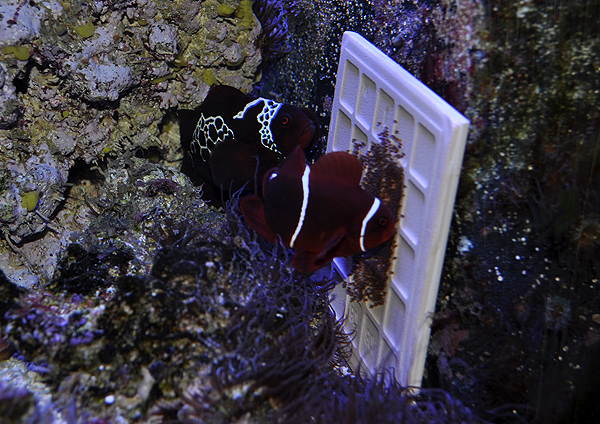




Recent Comments